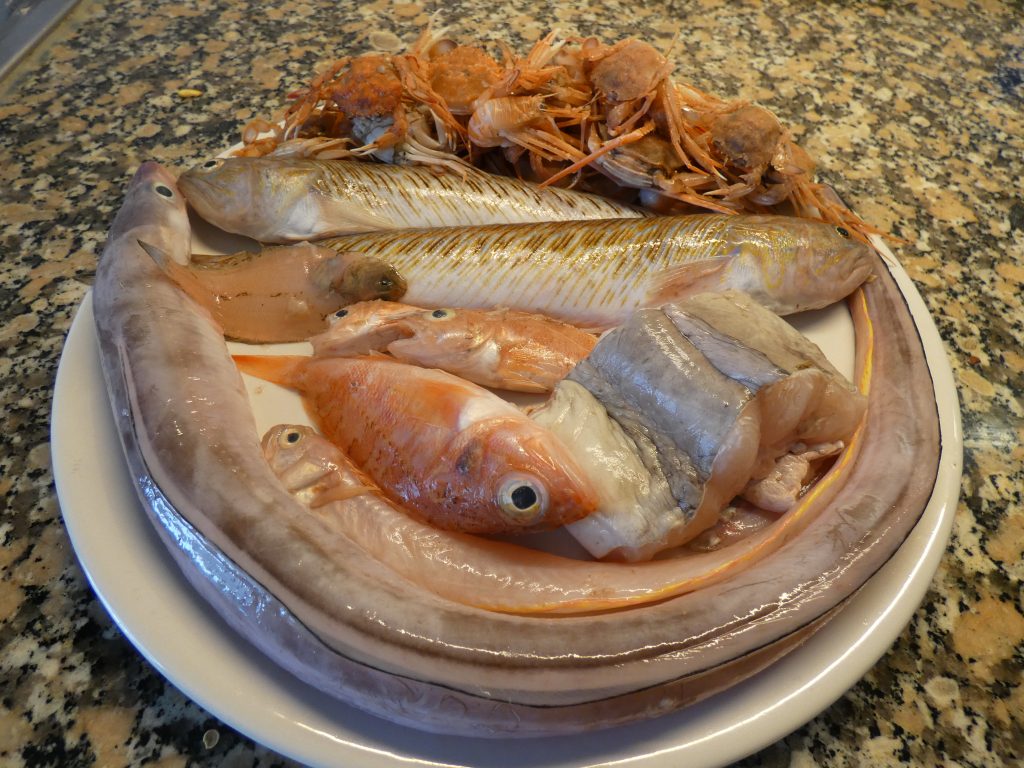This is a general-purpose fish stock recipe, especially useful for the elaborations in this book, although of course fish stocks made according to other recipes or tastes could be used. Two types of stock are proposed: a soft one, perfect to use in Romescos without imposing its own flavor; and another more intense stock, which can be used in rice and noodles, in the arromescadas versions that are presented in this book.
Soft stock (for Romescos).
Ingredients for 1 l of stock.
• 500 g of assorted ocean fish and crustaceans to make stock (fish for soup).
• 1 l of mineral water.
• 10 black peppercorns.
• 2 bay leaves.
Preparation.
• We clean the fish from gills and eyes, especially those larger fish. The crustaceans are cut into pieces with kitchen scissors, especially the larger ones.
• Put the fish, bay leaves and pepper in a saucepan with water and bring everything to a boil. When it starts to boil, it is put on a very low heat and simmered for 20 minutes.
• We turn off and let it rest for 20 more minutes in infusion.
• We strain well and restore the water lost during cooking with more water to complete the liter.
Intense stock (for romesqued noodles and rice).
Ingredients for 1 l of stock.
• 1 kg of assorted ocean fish and crustaceans to make stock (fish for soup).
• 1 l of mineral water.
• 10 black peppercorns.
• 2 bay leaves.
• 2 carrots.
• 1 leek.
Preparation.
• We clean the fish from gills and eyes, especially those larger fish. The crustaceans are cut into pieces with kitchen scissors, especially the larger ones.
• We clean and chop the vegetables.
• We put everything in a saucepan with water and bring to a boil.
• When it starts to boil, adjust to a very low heat and boil very gently for 20 minutes.
• We turn off and let it rest for 20 more minutes in infusion.
• We strain well and the water lost during cooking is restored with more water to complete the liter.
General comments about fish stocks.
• Salt: it is preferable not to put any salt in the stock; We will adjust the salt in the stew once the stock has been poured into it.
• Prawn heads and prawn skins: if we have prawns, it must be taken into account that the prawn heads and skins add an exquisite flavor to the stock. In this case, the prawns can be peeled and added to the stew, having used their heads and skins in the preparation of the stock.
• Pre-frying the fish: it may be a good idea to lightly fry the cleaned fish for soup in a little oil at the bottom of the pan (especially chopped shellfish), before adding the water to start cooking. Something similar could be said for vegetables in the case of the intense stock recipe.
• Water for the stock: it is important to use mineral water. The difference in taste can be a lot.
• Cooking the stock: it is not necessary to keep the fish stock cooking for a long time. In about 20 minutes, the fish will have given the stock all the substance it can offer, so it makes no sense to cook it much longer, since this would only dissolve the calcareous parts of the shellfish and lose its aromas. For similar reasons, it is advisable not to bring the stock to a boil in a very energetic or bubbly way, being preferable to do so over a very low heat, so that the bubbles from the boil are barely noticeable.
• Infusion: once the heat is turned off, it is advisable to let the stock infuse for 20 more minutes before passing it through the strainer.
• When a Romesco is made from a whole fish (for example, a whole turbot for four people) the fish stock can be prepared with the remains of cleaning the turbot, excluding the guts, gills and eyes. This will take full advantage of the piece of fish and it will not be necessary to buy fish for soup separately to make the stock.
• Commercial stocks: if you want to avoid making the stock at home, you can use a prepared commercial fish stock. In this case, it is advisable to use commercial fish stocks of the best possible quality.

